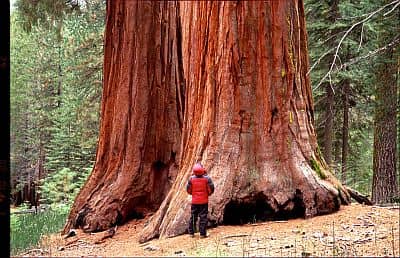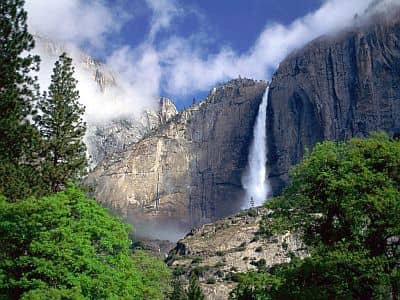Select units of measurement for the temperature and rainfall tables (metric or imperial).
Average weather, temperature, rainfall, sunshine hours
The
climate in the Yosemite National Park, located in California, along the mountain range of Sierra Nevada and about 250 kilometers (155 miles) east of San Francisco, varies mainly with altitude, and experiences significant differences in temperature between night and day. In general, however, winter is cold, while summer is the sunniest and driest season.
In the few areas located
below 1,000 meters (3,300 feet), such as in
El Portal, a village located in a valley and 600 meters (2,000 feet) above sea level, winter is mild enough, in fact, the average temperature in January is 7.5 °C (45.5 °F), although it can get cold at night, with some night frosts. Summer is hot and dry, with hot days, averaging around 33/34 °C (91/93 °F), but with peaks over 40 °C (104 °F). The rainfall in this secluded valley is scarce, around 290 mm (11.5 in) per year.
Here are the average temperatures in El Portal.
El Portal - Average temperatures|
| Month | Min | Max | Mean |
|---|
| January | 3 | 12 | 7.5 |
|---|
| February | 5 | 15 | 10 |
|---|
| March | 6 | 18 | 12 |
|---|
| April | 8 | 22 | 15 |
|---|
| May | 12 | 27 | 19.5 |
|---|
| June | 14 | 31 | 22.5 |
|---|
| July | 17 | 34 | 25.5 |
|---|
| August | 17 | 33 | 25 |
|---|
| September | 14 | 31 | 22.5 |
|---|
| October | 11 | 25 | 18 |
|---|
| November | 6 | 17 | 11.5 |
|---|
| December | 3 | 12 | 7.5 |
|---|
| Year | 9.7 | 23.1 | 16.35 |
|---|
Between 1,000 and 1,500 meters (3,300 and 4,900 feet), where there are the
main towns, which are usually located in inland valleys, like Wawona, winter gets colder: during the night, the temperature often drops below freezing (0 °C or 32 °F), and heavy snowfalls are possible; the temperature can drop to -15/-20 °C (-4/5 °F) in the worst moments. In summer, it's hot during the day, with highs often above 30 °C (86 °F), but nights remain cool: the daily temperature range is remarkable. Sometimes in mid-summer, there can be very hot days, with peaks of 40 °C (104 °F) and more, while in other situations, the temperature can approach the freezing point at night.
In
Yosemite Village, in the valley of the same name and at 1,200 meters (3,900 feet) of altitude, the
average temperature of the coldest month (December) is of 2.7 °C (36.8 °F), that of the warmest month (July) is of 22.9 °C (73.3 °F). Here are the average temperatures.
Yosemite Village - Average temperatures (1991-2020) |
| Month | Min | Max | Mean |
|---|
| January | -1.9 | 8.6 | 3.3 |
|---|
| February | -1 | 10.7 | 4.8 |
|---|
| March | 0.8 | 13.7 | 7.3 |
|---|
| April | 3.1 | 17.3 | 10.2 |
|---|
| May | 6.9 | 21.4 | 14.2 |
|---|
| June | 10.6 | 26.9 | 18.8 |
|---|
| July | 14.1 | 31.8 | 22.9 |
|---|
| August | 13.8 | 31.7 | 22.7 |
|---|
| September | 10.8 | 28.3 | 19.6 |
|---|
| October | 5.2 | 21.6 | 13.4 |
|---|
| November | 0.3 | 13.3 | 6.8 |
|---|
| December | -2.3 | 7.7 | 2.7 |
|---|
| Year | 5.1 | 19.5 | 12.25 |
|---|
In the park,
precipitation follows the Mediterranean pattern, ie with a maximum in winter and a minimum in summer, especially at medium and low altitudes, while at higher altitudes, some afternoon downpours or thunderstorms can break out during summer. In quantity, precipitation varies with altitude and slope exposure: it generally increases with altitude, but it's also more abundant along the western slopes.
In Yosemite Village, 930 millimeters (36.5 inches) of rain (or snow) fall per year, with a pronounced minimum in summer, when the rains are very rare. Here is the average precipitation.
Yosemite Village - Average precipitation| Month | Days |
|---|
| January | 175 | 9 |
|---|
| February | 165 | 9 |
|---|
| March | 140 | 11 |
|---|
| April | 80 | 7 |
|---|
| May | 50 | 6 |
|---|
| June | 10 | 2 |
|---|
| July | 5 | 1 |
|---|
| August | 5 | 1 |
|---|
| September | 10 | 2 |
|---|
| October | 40 | 4 |
|---|
| November | 105 | 6 |
|---|
| December | 140 | 8 |
|---|
| Year | 930 | 67 |
|---|
At
high altitudes, about 2,000 meters (6,500 feet), winter is definitely cold, often snowy and freezing, while in summer, it can be hot during the day, but nights remain cool (or even cold).
Here are the average temperatures in
Lee Vining, located to the east of the park, near Mono Lake, at 2,000 meters (6,500 feet) of altitude.
Lee Vining - Average temperatures (1991-2020) |
| Month | Min | Max | Mean |
|---|
| January | -6.3 | 4.9 | -0.7 |
|---|
| February | -5.2 | 6.7 | 0.8 |
|---|
| March | -2.4 | 10.6 | 4.1 |
|---|
| April | 0.3 | 14.4 | 7.3 |
|---|
| May | 4.2 | 19 | 11.6 |
|---|
| June | 8.5 | 24.8 | 16.6 |
|---|
| July | 12.1 | 29 | 20.6 |
|---|
| August | 11.3 | 28.3 | 19.8 |
|---|
| September | 7.5 | 24.4 | 16 |
|---|
| October | 2.2 | 18.4 | 10.3 |
|---|
| November | -2.3 | 11.6 | 4.6 |
|---|
| December | -5.7 | 5.7 | 0 |
|---|
| Year | 2 | 16.5 | 9.25 |
|---|
At even higher altitudes, winter is really cold, with night temperatures well below freezing, and the coldest records about -30 °C (-22 °F), while summer is mild during the day and cold at night, with possible slight frosts even in July and August.
Here are the average temperatures near
Ellery Lake, almost 3,000 meters (9,800 ft) above sea level.
Ellery Lake - Average temperatures|
| Month | Min | Max | Mean |
|---|
| January | -12 | 2 | -5 |
|---|
| February | -12 | 2 | -5 |
|---|
| March | -10 | 4 | -3 |
|---|
| April | -7 | 7 | 0 |
|---|
| May | -3 | 10 | 3.5 |
|---|
| June | 1 | 15 | 8 |
|---|
| July | 6 | 20 | 13 |
|---|
| August | 5 | 20 | 12.5 |
|---|
| September | 2 | 16 | 9 |
|---|
| October | -2 | 10 | 4 |
|---|
| November | -7 | 6 | -0.5 |
|---|
| December | -10 | 3 | -3.5 |
|---|
| Year | -4 | 9.6 | 2.8 |
|---|
On the highest peaks, around 4,000 meters (13,000 ft), there are glaciers along the north-facing slopes, such as the Lyell Glacier and the Maclure Glacier. The highest peaks are located in the eastern part of the park, and are Mount Lyell, 3,997 meters (13,113 feet) high, and Mount Dana, 3,979 meters (13,054 feet) high.

In the Yosemite National Park, the
sun shines all year round, but especially in summer, when the sky is normally clear. Here are the average sunshine hours per day in Lee Vining.
Lee Vining - Sunshine hours| Month | Average | Total |
|---|
| January | 7 | 210 |
|---|
| February | 8 | 230 |
|---|
| March | 9.5 | 300 |
|---|
| April | 11 | 335 |
|---|
| May | 12 | 370 |
|---|
| June | 12.5 | 380 |
|---|
| July | 13 | 405 |
|---|
| August | 12 | 380 |
|---|
| September | 11 | 335 |
|---|
| October | 10 | 305 |
|---|
| November | 7.5 | 220 |
|---|
| December | 6.5 | 195 |
|---|
| Year | 10 | 3665 |
|---|
Best Time
The
best time to visit the Yosemite National Park is the
summer, from June to September. July and August are the warmest months, or the least cold at high altitudes. In June and September, the temperature is lower by a few degrees, but there are also fewer tourists. Given that the temperatures vary depending on the altitude and the hour of day, it is advisable to dress in layers, bringing warmer clothes for the cold of the night and of high altitudes, and also to protect yourself against the sun (which in summer is very strong, especially in the mountains), with sunglasses and a hat.
Waterfalls are fed by the melting of snow, so they reach their peak in spring and early summer, ie in May and June, and then decrease during the summer, and stay at a low level in autumn. In August, some waterfalls may be dry.
The roads located at higher elevations, such as the Tioga Road, which reaches as high as around 3,000 meters (9,800 ft) in the Tioga Pass, are usually opened in June, while they are impassable until May because of snow (although there are variations from year to year depending on the snow fallen in winter).

In October, the first snowfalls occur at high altitudes; then, the snow line gradually decreases during autumn.
In winter, the road in Yosemite Valley is open, but snow chains are often required. In this period, you can explore nature in silence, or even do skiing and cross country skiing in the Badger Pass Ski Area, one of the few ski areas within America's national parks.
To the east of Yosemite National Park, the landscape is semi-desert. Not far away, we find the ghost town of
Bodie, 2,500 meters (8,200 ft) above sea level, and
Mono Lake, a very salty and alkaline lake, 2,000 meters (6,500 feet) above sea level. They are both accessible from the Tioga Road, when it is not closed because of snow (hence, usually from June to September).
Back to
California.